5 Interesting Things to Know About a Cat Kneading
At some point, you may have observed your feline friend pushing their front paws onto a soft surface. Whether those paws are rhythmically squishing into a thick blanket or your body, cat kneading is a common site in some cat households. (There are some cats who don't knead or who only knead infrequently, and that's okay.) If you've ever wondered, Why do cats knead?, read on to discover more about why kitties — big and small, wild and domestic — perform this behavior.
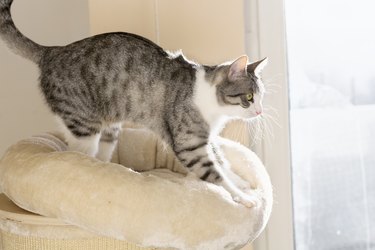
Video of the Day
1. Reasons why cats knead
Kneading is a common behavior that is instinctual and starts in kittenhood. In order to stimulate milk from their mother, a kitten will push their front paws with an alternating motion — one paw, then the other — onto their mother's belly around the nipple to stimulate milk production.
Video of the Day
It's theorized that one reason adult cats knead is because it makes them feel happy. Another theory is that it's an automatic behavior when a cat feels a soft object under their paws. Cats also have scent glands in their front paws, so it's possible they knead to distribute pheromones to mark territory, such as their favorite soft blanket.
Female cats also knead while they're in heat. Purring, kneading, and meows from a cat who isn't spayed are feline behaviors that tells male cats that the female is receptive to mating.
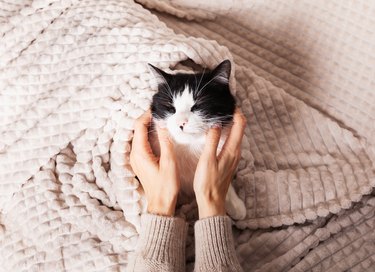
2. Can cat kneading be a sign of a problem?
Sometimes, cat kneading can be a sign of a problem. Even though it's a natural behavior, some cats may knead excessively out of stress, so if your cat is suddenly kneading more than usual, contact your veterinarian. Sometimes this can be due to a change in your schedule, such as you're now gone more than usual. Another possible stressor is a change in the home environment, such as loud renovations going on in the home or a change in who is living there, both animal and human.
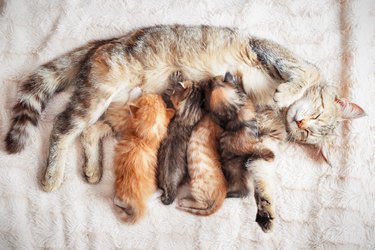
3. Do kittens learn to knead from their mother?
No, kittens don't learn to knead from their mother. Kneading behavior is instinctual. When a kitten alternately pushes their front paws on their mother's belly, they are stimulating the flow of milk to facilitate suckling.
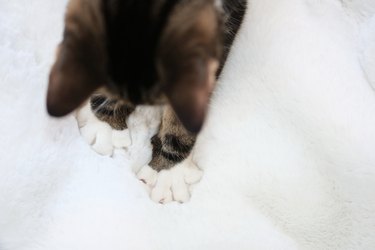
4. Is a cat drooling and kneading normal?
Yes, a kitty who is simultaneously drooling and kneading is exhibiting normal cat behaviors. When a cat is content, it's not unusual for them to have saliva drip from their mouth. Some cats may also purr at the same time as they're drooling. However, if your cat is drooling when they are not kneading, that is a sign of a medical problem and requires prompt veterinary attention.

5. Wild cats and big cats like lions and tigers knead
Your cat's original wild ancestor is the African wildcat, or Felis sylvestris lybica, who still roams in Africa and parts of Asia. Like domestic cats, wild cats such as lions and tigers knead as part of nesting behavior. Domestic cats might still act out this instinctual behavior. They're checking to see if the surface is suitable and it's a way to fluff up the space, kind of like fluffing a pillow.
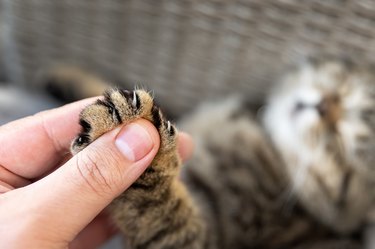
Here are some additional questions people ask about cat kneading
What does it mean when a cat kneads on a blanket?
It's believed that cats knead on blankets because the soft texture feels similar to their mother. When a kitten kneads on their mother, they are comforted and rewarded with milk. An adult cat may continue to feel this sense of comfort that they felt when they were younger.
What does it mean when a cat is purring and kneading?
A cat who is purring and kneading is one content kitty! Though a cat can purr when they are not content (such as at the veterinarian's office) and even knead more when stressed, the two behaviors together indicate satisfaction.
What should I do when my cat kneads me?
If you enjoy being kneaded on by your cat, you can let them continue for as long as you feel comfortable. Feel free to lightly pet your cat, unless that seems to overstimulate them. (An overstimulated cat might lightly bite but it's not to be mean.) If, however, you don't want your cat to knead you, you can redirect them to another soft surface, such as a blanket. Consider applying a feline pheromone spray to the blanket to encourage your cat to knead there.
Cat owners who don't want to deter kneading but find the behavior uncomfortable because their cat's claws are sharp, should trim their cat's nails every two to three weeks. Another option is using nail caps, such as Soft Paws. It's also good to keep a blanket handy that you can place over your lap to protect your skin from sharp claws.
Why is cat kneading called "making biscuits"?
Cat kneading is called "making biscuits" because it's similar to a person kneading dough. Both cat and person use an alternating push and pull motion while kneading.